Everything you should know about trains in Italy
To be fair, for the first five years of my travels to Italy, I had always used the train to get around. That’s mainly because I lived, studied, and worked in Trieste and Rome. Both towns have great train connections.
However, as I’ve started traveling to the south of Italy, I discovered trains aren’t always an option. Even when traveling in the northern part of Italy for the first time, navigating the various train operators, transfers, ticket options, and other details can be challenging.
That’s why I decided to write this – to help you better understand trains in Italy. Moreover, choose the best option for your travel style and itinerary.
This post contains affiliate links to products and services that I may be compensated for, at no extra cost to you. Read more about this on our disclosure page here.
Table of Contents
Trains in Italy – what you should know
Regional trains vs High-speed trains
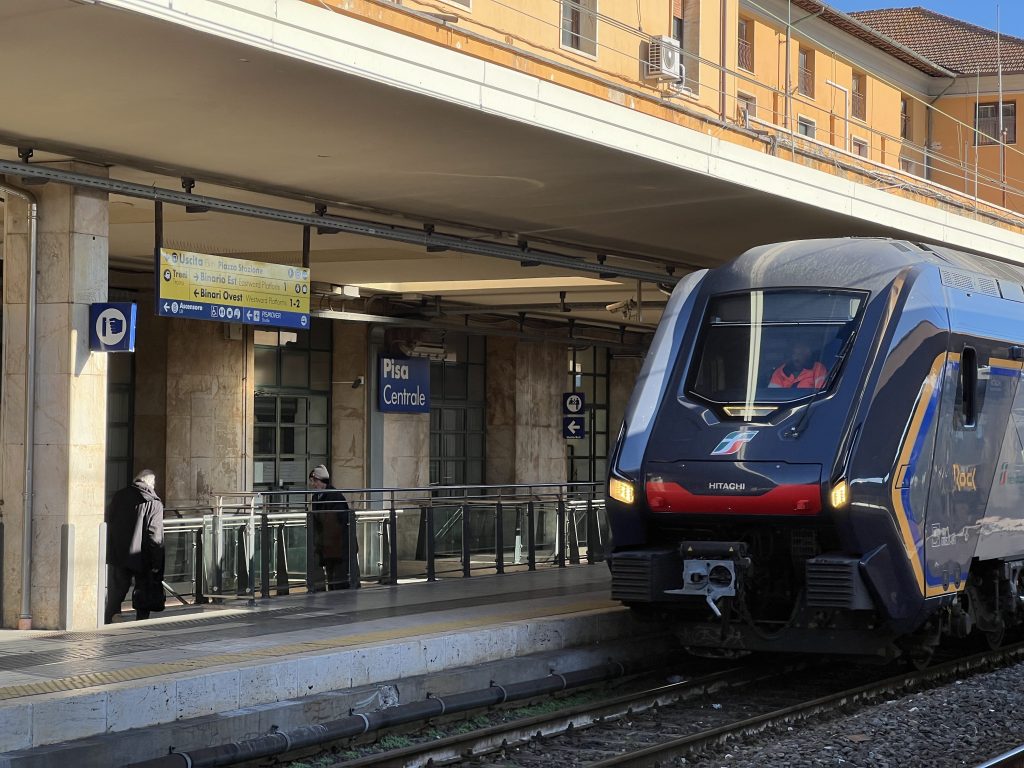
As a student, I would always travel by regional train. That’s mainly because I was very conscious of my budget, but also because I had free time and traveled small distances.
Later on, as I began to discover Italy more, I understood the difference between regional trains and high-speed trains. But also when to choose the second option, and when not to.
Regional Trains (Treno Regionale)
Regional trains are designed for short-distance travel within regions or between neighboring regions. They are ideal for exploring smaller towns and less touristy destinations.
For example, here in Tuscany, we have the TuscanLines – trains that link smaller and larger towns around the region.
There are 2 types of regional trains: Regional and Regional Veloce (RV)
The regional trains are slower and stop at all the small-town stations. On the other hand, RV trains are faster and make fewer stops.
What to know about buying tickets for regional trains:
Usually, you don’t need to buy them in advance because ticket prices are fixed. You will be assigned a seat, and you must validate the ticket before boarding the train.
Extra tip: If you forget to validate your ticket and you board the train, you can write the date and time with a pen on the ticket.
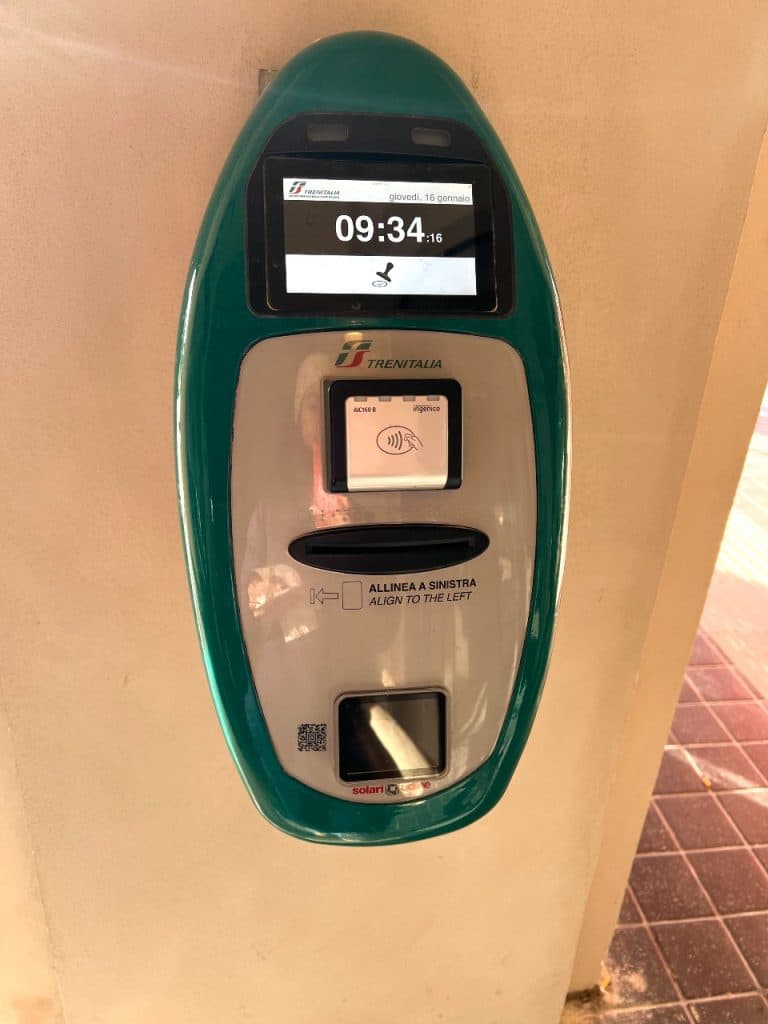
Also, be sure to purchase your ticket before boarding the train. I’ve read about people who have been fined because they thought they could buy the ticket on board the train.
Moreover, in certain train stations (such as Florence, for example), you cannot access the platform without a valid train ticket.
When it comes to comfort, regional trains are the most basic trains you could travel with in Italy, with limited onboard amenities.
Another thing worth knowing is that train strikes usually affect regional and RV trains first.
High-Speed Trains (Le Frecce: Frecciarossa, Frecciargento, Frecciabianca)
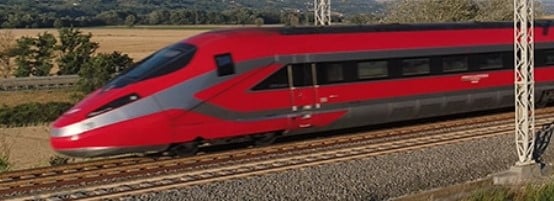
Also known as “Le Frecce” (the arrows), these fast trains are operated by Trenitalia, the state-owned (public) train company. These trains connect major cities across Italy, offering faster and more comfortable travel options.
Depending on where you are traveling within Italy, you will be able to choose between 3 trains.
Booking your ticket for high-speed trains in advance offers you access to great offers and discounts.
Additionally, a seat is allocated once you purchase your ticket, and this is valid only for the specific train for which you booked it. Thus, you don’t have to validate your ticket before boarding the train.
Frecciarossa
The train travels up to 300 km/h and it connects most cities in Italy. You can see the routes served by Frecciarossa in the map below:
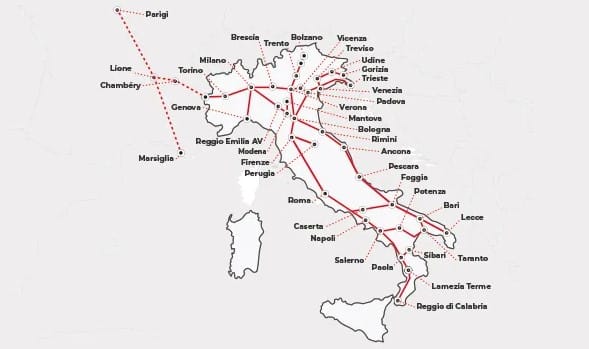
Services available on Frecciarossa trains:
- Air conditioning
- Plug sockets for each seat
- LED lighting
- Ample luggage space
- Screens in all carriages with continually updated travel information and news
- 2 designated spaces equipped for disabled passengers travelling in wheelchairs and two seats for their travelling companions
- Baby changing table
Moreover, Frecciarossa trains offer 3 or 4 service levels: Executive, Business, Premium, and Standard.
Frecciargento
The train travels at speeds of up to 250 km/h, connecting Rome to the southern part of the peninsula, as well as to Florence or Genoa.
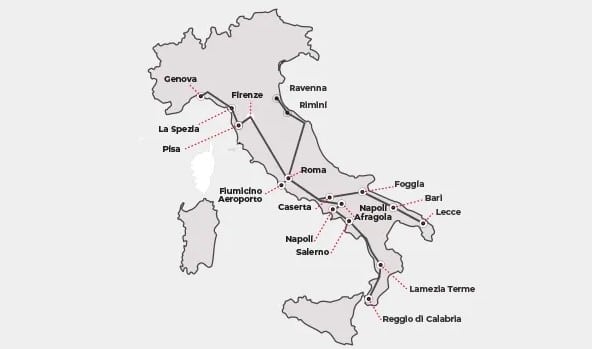
The Frecciargento trains are equipped with:
- Reclining chairs;
- Air conditioning system ;
- Power outlets and courtesy lights for each seat and coat hooks near the window;
- Spaces for large luggage in both carriages and vestibules;
- Monitors in each carriage display continuously updated information on the journey’s progress, news, and other useful details.
- Two seats for disabled people travelling in wheelchairs and two seats for companions;
- Changing table.
Additionally, they comprise 9 carriages, accommodating a total of 489 seats, with 3 first-class, five second-class, and the FRECCIA Bistrò carriage.
Frecciabianca
The train travels at speeds of up to 200 km/h, connecting Rome to Torino, Milan, Genoa, and Pisa.
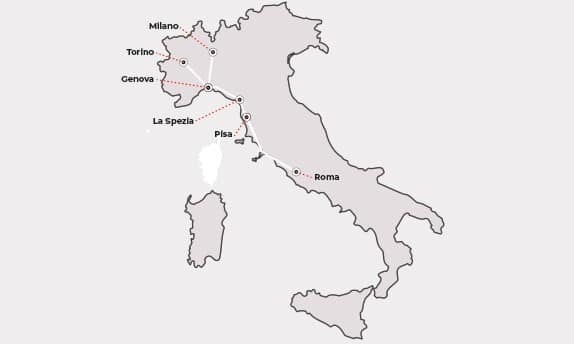
The Frecciabianca trains are equipped with:
- Spacious armchairs and folding tables at the seat
- Air conditioning system
- Power sockets in place
- Courtesy light
- Clothes hooks near the window
- Ample space for large luggage
- Public address system for updates on train stations and Trenitalia services
- Changing table in the toilet of carriage 3 is available to all customers
Le Frecce vs ItaloTrain
For a long time, I was confused as well, and to be fair, I knew nothing about Italo. In my defense, they weren’t around when I first came to study in Italy, and they were very small during my time in Rome.
However, today, Italo is an excellent option for high-speed trains. They operate modern, high-speed trains that reach speeds of up to 300 kilometers per hour.
Italo trains offer several service levels, including Smart, Prima, Club Executive, and others. You can expect good amenities, a more modern design, and lounge service in higher classes.
When it comes to pricing as compared to Trenitalia, Italo has generally competitive pricing, especially for advance bookings. Even more so, sometimes it is cheaper for similar routes/times depending on demand.
Here’s a comparison for train ticket prices, on the same date and same route:
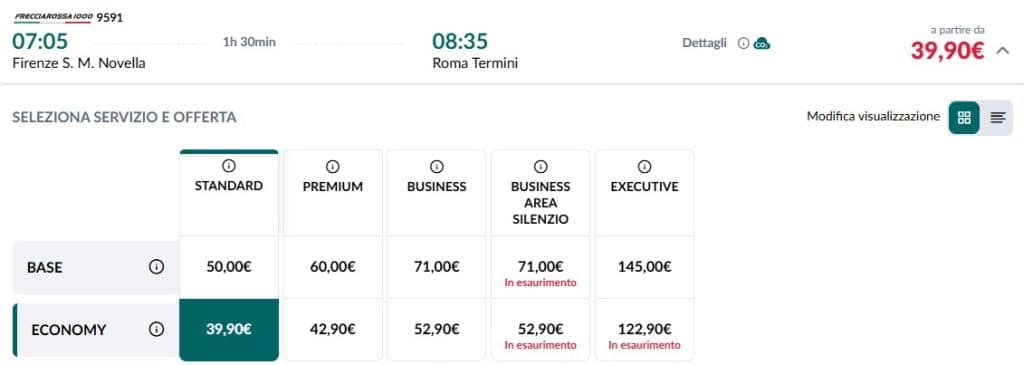

If you still cannot decide, here are a few pros and cons for each:
Pros of Le Frecce
• More route options across Italy – if you need to get to less-touristy towns or more connections, Frecce might serve you better.
• More frequent departures during the day.
• Classes like Executive are very premium – good for comfort.
Pros of Italo
• Often offers more modern interiors and somewhat better punctuality in many comparisons.
• Competitive fares when booked in advance.
• Very strong services in its higher classes (e.g., Club Executive), nice lounges, and good onboard amenities.
Cons / Trade-offs
• If you wait too close to your travel date, both can get pricey – Le Frecce maybe more so.
• Depending on the station, Italo might stop at less convenient stations or have fewer frequency options off-peak.
• Frecciarossa trains are iconic and very comfortable, but at peak times, things fill up quickly.
Other FAQ about trains in Italy
What to know about trains when there is a strike in Italy

I always tell people to check online for any strikes taking place. Unfortunately, this happens quite frequently in Italy.
The best way to ensure you have the latest information is to look for it in Italian. Search for “sciopero treni” and you can easily translate the results.
Both the Trenitalia and Italo websites have announcements similar to the above one informing travelers about strikes (when there is an upcoming one). Also, both companies have guaranteed trains and connections. These usually occur during the peak times in the morning and evening.
Moreover, high-speed trains and those operated by private companies are less impacted by cancellations due to strikes.
Are there any additional costs you should be aware of?
When you buy tickets online, the system will add transaction costs to the ticket’s cost. That is not the case, however, when you buy the ticket from the train station – machine or counter.
What if your flight is late and you have already bought the ticket?
No worries. The tickets for the regional trains can be used for any regional train that operates on that route.
However, for the high-speed train, you should pay extra and get the Flexible option – this allows you to make changes to your itinerary.
What if you buy your ticket and there is a strike?
You will receive a full reimbursement if the train is cancelled due to the strike.
How far in advance can you buy your ticket?
You can buy your tickets starting around 6 months before your trip. However, the maximum time also depends on availability and offers, such as Super Economy or same-day return fares, which have tighter deadlines.






